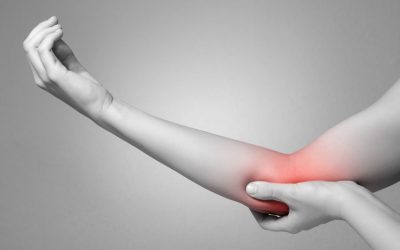None of us are invincible. We all have vulnerabilities and from time to time we can all get aches and pains from overusing our body, adopting unfavourable awkward positions, or performing repetitive and high-intensity tasks for prolonged periods without rest, or allowing for adequate recovery. When this causes pain originating from our muscles, nerves, and tendons it is referred to as a Repetitive Strain Injury (RSI). As it is more common in the upper limb, including the forearms, wrists, elbows and hands, it may also be referred to as work-related upper limb disorder or non-specific upper limb pain.

(Copyright: Siam Pukkato)
RSI can be a serious and debilitating condition. According to the Health and Safety Executive (HSE) RSI affects up to 500,000 worker each year in the UK, and the Trade Union Congress (TUC) estimates that 300,000 working days are lost each year due to RSI.
What are the risk factors for RSI?
The main risk factors for RSI are:
- Awkward static postures – such as sitting. standing, and reaching for long periods.
- Overuse – repetitive movements/vibration stress – such as performing a single task continuously or working with drills.
- Forceful exertion such as heavy lifting.
- Performing tasks with poor technique.
Other risk factors include working in cold temperatures, lax-joints, stress, lack of rest, lack of exercise, sedentary life-styles, poor sleep, smoking, diabetes, and arthritis.
What does having an RSI feel like?
The symptoms of RSI usually develop gradually and can vary widely depending on the cause of the problem and the area affected. The symptoms can range from very low-level intensity to more severe pain. Sufferers often describe symptoms of pain, throbbing, aching and tenderness in the affected area. They may also describe symptoms of numbness, tingling, weakness/clumsiness and cramping in the limb. Swelling can be present, but often there are no visible signs.
In clinic, patients may describe noticing the pain only when carrying out a particular repetitive action, for example, clicking a mouse button whilst using your computer or performing a backhand in tennis. In the initial stages, the symptoms usually settle when the activity is stopped. But when this does not happen the symptoms can reoccur increasing in frequency and intensity, eventually becoming present all the time and worsen during the repetitive task. Without adequate rest and appropriate treatment RSI can become debilitating. This can sometimes lead to time off work and stop you doing the activities you like doing for many months.
Why does RSI cause so much of a problem?
Well….the reason why RSI can become such a problem is that it can affect any one or more of the following:
- Tendons – tendons are structures that attach muscle to bone. Overuse of tendons through repetitive movements can cause damage in the form of micro-tears, which can lead to inflammation. When tendons become tender and swollen it is called tendonitis. Some tendons are wrapped in a protective lubricating sheath and can become thickened due to friction from the tendon running through the sheath. When this becomes inflamed it is referred to as tenosynovitis.
- Muscle & connective tissue – muscles contract to allow joints to move. Repetitive quick movements or holding a muscle under tension for a long time can inhibit blood flow through the muscle and may also lead to inflammation, pain and scar tissue build up. This can also affect the connective tissue (fascia) in which the muscles lie.
- Nerves – nerves carry electrical impulses from the brain to supply our muscles and organs. These nerves can become trapped or compressed at various sites along their path by tendon and muscle. Sometimes more than one location can be involved. This can result in pins and needles and weakness in the affected area.
- Blood flow – swelling and inflammation of body tissues can also restrict blood flow through our blood vessels, which can lead to tingling, pain, the feeling of coldness and numbness in the affected area.
Common examples of repetitive strain injuries include the following:
- Bursitis – the bursa is a fluid filled sac that provides a cushion between bones, tendons, joints and muscles. This can become inflamed and swollen e.g. at the elbow or shoulder.
- Nerve entrapment disorders – for example carpal tunnel syndrome where by the median nerve can become compressed in the wrist area causing numbness and pain in the hand.
- Dupuytren’s Contracture – a thickening of the tissues in the hand, which causes one or more fingers to bend into the palm.
- Epicondylitis – inflammation of the area where bone and tendon join from strenuous overuse of the muscles and tendon e.g. Tennis Elbow & Golfer’s Elbow.
- Ganglion cyst – a spongy sac of fluid that forms around a joint or tendon, usually on the wrist or fingers.
- Rotator cuff syndrome – inflammation of the tendons and muscles around the shoulder.
- Trigger finger- where swelling in a tendon running along one of the fingers makes it difficult to either bend or straighten the affected finger.
What do I do if I think I have RSI? And how do I go about treating it?

(Copyright : Nipon Temsakun)
If you believe that you have an RSI, firstly identify what may be responsible for causing it. By making small lifestyle changes and modifying the activity causing the RSI may help give symptom relief. Sometimes it might be necessary to avoid the activity completely to give adequate time for recovery.
RSI may be occupationally related and you may need to speak to your employer to make modifications to your workstation or schedule. The following tips maybe helpful:
- If you perform repetitive tasks or sustain awkward postures, take regular breaks from your work station to get up and walk around, and stretch tight muscles.
- Practice good posture – If you continually struggle to maintain good posture, adjust your workstation or chair to reduce strain on your body. Maybe a more ergonomically designied chair may help.
- Exercise regularly – aiming to get a good balance of strength, flexibility, and stamina. Pilates and Yoga are good examples of exercise that may help.
- Avoid over stretching you arms, hands and wrists.
- When writing, try to avoid gripping too hard.
For those who take part in regular sport and exercise, or even play a musical instrument, it is important to warm-up and cool-down properly before and after the activity, as well as taking regular rest periods to allow your body to recover and adapt minimising the likelihood of injury.
For persistent symptoms that do not resolve by modifying activities or life style, an assessment should be carried out by your GP or suitably qualified health profession, such as an Osteopath or Physiotherapist. They would examine the area of pain and ask about your symptoms and medical history to diagnose the problem correctly and provide the appropriate treatment, advice or referral. Sometimes your GP may refer you for blood tests to rule out any underlying inflammatory joint conditions, as well as imaging (e.g. x-rays) to identify if there is osteoarthritis.
Possible treatment options for RSI include:
- Your health professional may recommend cold packs, elastic supports or splints to help reduced inflammation.
- Medication – To relieve symptoms, your GP may advise taking a short course of anti-inflammatory painkillers (such as aspirin or ibuprofen). If your symptoms are disrupting your sleep they may recommend pain receptor-blocking medications, such as some forms of antidepressants
- Osteopathy, Physical Therapy & Acupuncture – hands-on treatment approaches, acupuncture as well as advice on posture, stretching and strengthening exercises can be used to help ease pain and relax muscles.
- Steroid injections – in certain circumstances when the inflammation is more severe and more conservative measures have failed a steroid injection may be used.
- Surgery – as a last resort in order to correct specific problems with nerves or tendons, where other treatments have failed, surgical intervention may be indicated.
RSI is preventable and treatable, and prevention is better than cure. If you are aware that your working environment or the activity you are doing is putting you at risk taking steps to moderate or making modifications to allow your body to have the opportunity to recover and rest is always the best way to go, and it is vital not to ignore those early warning signs, such as the odd niggle.
If you have any concerns about your symptoms and would like to find out how Osteopathic treatment can help why not give us a call on 0161 478 1877.
REFERENCES
www.nhs.uk/conditions/repetitive-strain-injury/
www.rsi.org.uk
https://digitalcommons.usu.edu/cgi/viewcontent.cgi?article=1384&context=extension_curall
https://www.csp.org.uk/publications/repetitive-strain-injury-rsi
https://fit2wrk.com/wp-content/uploads/2015/08/ARTICLE_Fit2wrk_ClinicalEd_vol1-11.pdf
www.csp.org.uk/sites/files/csp/secure/RSI_HS_%20briefing_08.pdf
https://www.abilitynet.org.uk/sites/abilitynet.org.uk/files/RSI Dealing with Repetitive Strain Injury in the workplace Final Sept 2015.pdf
https://www.unison.org.uk/content/uploads/2013/06/Briefings-and-CircularsRSI-Health-and-Safety-Information-Sheet3.pdf
(Header featured image copyright : Csaba Deli)




